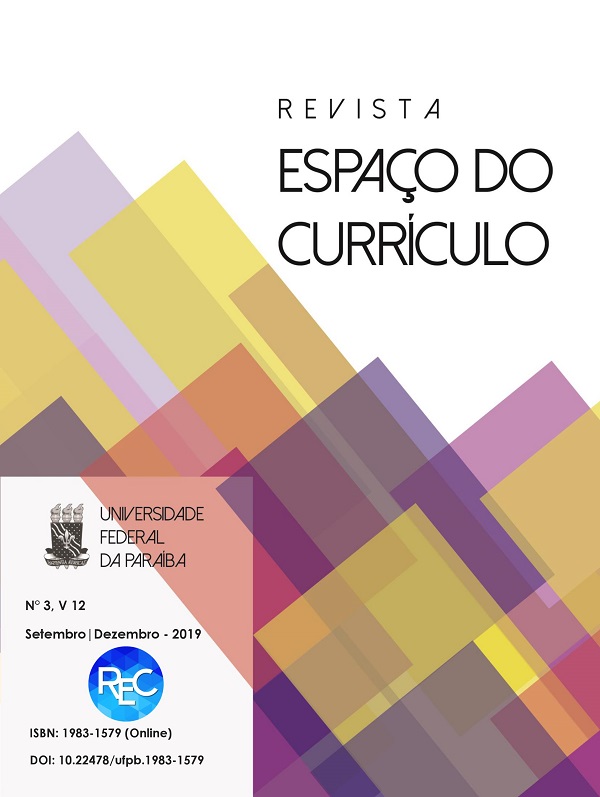PARANÁ OBSERVATORY
the curriculum movement of degrees in visual arts
DOI:
https://doi.org/10.22478/ufpb.1983-1579.2019v12n3.46193Keywords:
Curriculum;, Art teacher training, Subjectivity, Knowledge, Artistic and pedagogical knowledgeAbstract
This study on the curricular movement of undergraduate degrees in Visual Arts has its origins in discussions about the specificity of artistic knowledge in art teaching, based on historical-critical pedagogy (SAVIANI, 2013). It seeks to think about the contribution of art teaching in the face of alienation, hostile and destructive power that the teacher faces (MÉSZÁROS, 2006), problematizing: the curriculum proposed in the degree in Visual Arts, at the University Federal (PR), corresponds to the qualification demands demanded of those who work in art education at elementary and high school levels? Is there adherence between specific artistic and pedagogical knowledge offered in the degree in Visual Arts (UFPR), the curricula of the Departments of Education and the contents covered in Basic Education? We sought to understand who the teacher of flesh and blood is, based on criticism, the tendency to place subjectivity “inside” and the social and cultural “outside” of the subject (GONZALEZ REY, 2012). It was found that this trend found expression in a more prescriptive training project and less adherent to the investigation of the teacher's subjective resources in coping with everyday situations in the classroom, such as the institutionalized practice of a single teacher working with all languages. Finally, how does he unravel the specific knowledge of art (what) and pedagogical (how) and what results from this amalgamation, in view of the increasingly adverse conditions in which the school is immersed in the current Brazilian context?
Downloads
Metrics
References
BARBOSA, Ana Mae. A imagem no ensino da arte: anos oitenta e novos tempos. São Paulo. Perspectiva; Porto Alegre: Fundação IOCHPE, 1991.
BRASIL. Parâmetros Curriculares Nacionais: arte. v. 6. Ministério da Educação. Secretaria da Educação Fundamental. 3 ed. Brasília: A Secretaria, 2001.
CANCLINI, Nestor G. A socialização da arte: teoria e prática na América Latina. 2 ed. São Paulo: Cultrix, 1984.
GONZÁLES REY, Fernando Luis. O social na psicologia e a psicología social: a emergência do sujeito. Petrópolis, RJ: Vozes, 2012.
______. Sujeito e subjetividade. São Paulo: Thomson, 2003.
______. Pesquisa qualitativa em psicologia: caminhos e desafios. Tradução de: SILVA, M. A. F. São Paulo: Thomson Pioneira Learning, 2002. Título original: Investigacíon cualitativa em psicologia.
KLEIN, Ligia Regina. Apresentação. In: CHAGAS, E. F.; RECH, H. L.; VASCONCELOS, R. e MATA, W. da (org.). Subjetividade e Educação. Fortaleza: Edições UFC, 2012. p. 7-18.
KLEIN, Ligia Regina. Alfabetização: quem tem medo de ensinar? 5. ed. São Paulo: Cortês; Campo Grande: Editora da Universidade Federal de Mato Grosso do Sul, 2008.
______. Proposta Político-Pedagógica para o Ensino Fundamental. Cadernos da Escola Guaicuru. Secretaria de Estado de Educação. Núcleo de Ensino. Mato Grosso, 2000.
KOSIK, Kosik. Dialética do concreto. 2. ed. Rio de Janeiro: Paz e Terra, 1976.
LUKÁCS, György. Estetica: la peculiaridad de lo estetico. Cuestiones preliminares y de principio. 2ª ed. Barcelona: Grijalbo, vol. 1. 1966.
MARTINS, Raimundo; TOURINHO, Irene. Educação na Cultura Visual: narrativas de ensino e pesquisa. Santa Maria: Ed. da UFSM, 2009.
MÉSZÁROS, István. A teoria da alienação em Marx. Tradução de: TAVARES, I. São Paulo: Boitempo, 2006. Título original: Marx’s theory of alienation.
OCHOA, César González. Imagen y Sentido: Elementos para uma semiotica de los mensajes visuales. México: Universidad Nacional Autónoma de México, 1986.
PAREYSON, Luigi. Os problemas da estética. 1.ed. Tradução de: GARCEZ, M. H. N. São Paulo: Martins Fontes, 1984. Título original: I problemi dell’estetica.
PEIXOTO, Maria Inês Hamann. Arte e grande público: a distância a ser extinta. Campinas: Autores Associados, 2003.
SAVIANI, Dermeval. Pedagogia histórico-crítica: primeiras aproximações. 11. ed. Campinas, SP: Autores Associados, 2013.
______. Educação: Do senso comum à consciência filosófica. 18. ed. Campinas, SP: Autores Associados, 2009.
SAVIANI, Nereide. Saber escolar, currículo e didática: problemas da
unidade/método no processo pedagógico. 4. ed. Campinas, SP: Autores Associados, 2003.
SCHAFF, Adam. História e verdade. 4. ed. São Paulo: Martins Fontes, 1987.
SCHLICHTA, C. A. B. D.; ALVARENGA, V. M. O currículo das licenciaturas em Artes Visuais no Paraná: do proposto na lei à formação e atuação do professor. In: BUJÁN, F.; FRADE, I. N.; FONSECA DA SILVA, M. C. da R & COHAS, M. G. de la E. (Org.). Investigación y Formación en Artes: Miradas desde América Latina. Valparaíso; Florianópolis: UDESC; Universidade de Playa Ancha; Selo Editorial Puntángeles, 2018.
VÁZQUEZ, Adolfo Sanchez. As ideias estéticas de Marx. Tradução de: COUTINHO, C. N. 2. ed. Rio de Janeiro: Paz e Terra, 1978. Título original: Las ideas esteticas de Marx.
______. Filosofia da praxis. 2 ed. Rio de Janeiro: Paz e Terra, 1977.
SECRETARIA DE ESTADO DA EDUCAÇÃO. Tradução de: CARDOSO, L. F. Currículo básico para a escola pública do estado do Paraná. Curitiba/ PR: Imprensa Oficial, 1990. Título original: Filosofia da praxis.
SECRETARIA DE ESTADO DA EDUCAÇÃO DO PARANÁ. Diretrizes curriculares da educação básica: Arte. Departamento de Educação Básica. Curitiba/ PR: Imprensa Oficial, 2008.
SECRETARIA MUNICIPAL DA EDUCAÇÃO. Currículo Básico: uma contribuição para a escola pública brasileira. Curitiba/ PR: Imprensa Oficial, 1898.
SECRETARIA MUNICIPAL DA EDUCAÇÃO. Currículo Básico: compromisso permanente para a melhoria da qualidade do ensino na escola pública. Impressão Coygraf: Curitiba, 1991.
Downloads
Published
How to Cite
Issue
Section
License
By submitting an article to Curriculum Space Journal (CSJ) and having it approved, the authors agree to assign, without remuneration, the following rights to Curriculum Space Journal: first publication rights and permission for CSJ to redistribute this article. article and its metadata to the indexing and reference services that its editors deem appropriate.
















